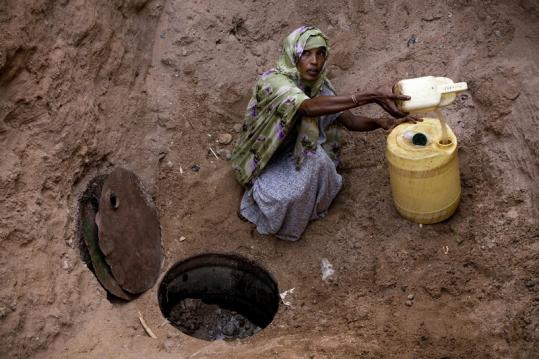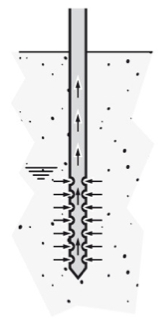Difference between revisions of "河床喷射井与管井"
From Akvopedia
| Line 5: | Line 5: | ||
这类井含有小口径的短筒筛(割缝管或穿孔管),筒筛通常会通过水压或人力,垂直或倾斜地插入疏松的沉积物中。在这种情况下,并不需要挖掘。 | 这类井含有小口径的短筒筛(割缝管或穿孔管),筒筛通常会通过水压或人力,垂直或倾斜地插入疏松的沉积物中。在这种情况下,并不需要挖掘。 | ||
| − | ===适宜条件 | + | ===适宜条件=== |
| − | + | 根据水泵的需求,最佳的水井选址为: | |
| − | * | + | * 距水泵处30米以内。 |
| − | * | + | * 为了使抽吸泵仍能运作(有效抽水6-7米高),则要在河堤不高、且洪水最高水位低于河堤的区域。 |
| − | * | + | * 河床在整个旱季都要有水。 |
{| border="1" cellpadding="5" cellspacing="0" align="center" | {| border="1" cellpadding="5" cellspacing="0" align="center" | ||
|- | |- | ||
| − | ! width="50%" style="background:#efefef;" | | + | ! width="50%" style="background:#efefef;" | 优势 |
| − | ! style="background:#f0f8ff;" | | + | ! style="background:#f0f8ff;" | 不足 |
|- | |- | ||
| − | | valign="top" | - | + | | valign="top" | - 修建速度快,成本低 <br> |
| − | - | + | - 入水口小,但可能产量高 <br> |
| − | | valign="top" | - | + | | valign="top" | - 较难在混有黏土的砂质沉积物中修建 <br> |
| − | - | + | - 没有像大口径水井那样的储水量 <br> |
| − | - | + | - 当需要维护水井或水井出现问题时,无法轻易接触到入水口<br> |
|} | |} | ||
| − | === | + | ===建造、运作与维护=== |
| − | + | 筛子(或称滤网)及管道系统离河床表面理想的最小深度应为1.5米,为的是: | |
| − | * | + | * 在雨季,河水泛滥时,地表水至少会有最小程度的渗透。 |
| − | * | + | * 井道与管道系统较不可能在洪水中被冲走。沙子在某一特定深度可以流动,而这一深度视河流不同而变化,但在季节性河床中,通常记录为0.66至2米之间。 |
| − | + | 使用的滤网直径可在32至200毫米中任选,长度则仅需0.5到1米。喷射井点通常用塑料制成;管井井点则通常由钢制成,在尖头处需要翼尖。 | |
| − | + | 喷射法(也称为冲洗钻井)是在饱和砂层中安装滤网的一种方法。喷射的方法和使用的管子规格均多种多样。关键技术提纲如下: | |
| − | * | + | * 需要约1000升水,根据工艺难易度和沉积物颗粒大小不同,可能需要更多。水可以用水车载来,或向地下挖洞并用塑料片材作内衬来产水。 |
| − | * | + | * 通常使用2” Honda(本田)抽吸泵(600升/分钟)来做喷射和试井,虽然更大容量的泵能喷射更深,但每分钟也会使用更多水。 |
| − | * | + | * 在喷射过程中,水从喷射管末端出来,向上流到地面。如果水流停止(比如,水流尽,或需要更换管子),喷射管/滤网周围的沙在多数情况下会塌陷,之后就不可能让水重新流向地面。然而,有些情况下,洞口仍然会保持敞开——只有在这些情况下,才能加入另一根管子,继续喷射;否则,能够安装滤网的深度将由单次不停泵的情况下喷射的长度来决定。 |
| − | * | + | * 挖大坑至地下水位是有益的,因为: |
| − | # | + | # 在易陷沙中,您可以喷射水流至坑的底部,随后,可以将额外的管子粘合到滤网上,以达到地面高度。以此方法,井能修得更深。 |
| − | # | + | # 由于水流为达到地表而必须克服的压位差减小,因而水柱消失的可能性已降至最低。压位差越高(即,从地下水位到地表的距离越大),水就越可能流向阻力最小的通道,在某种情况下会流入含水层,而并不会流到地面上来。水柱若在易陷沙中消失,则代表挖井终止,且井深就固定在这一深度。 |
| − | * | + | * 滤网末端可以装有球阀——在这种情况下,喷射管和滤网是由同一块材料制成的。或者,滤网也可与喷射管分离——在这种情况下,喷射管将洞打出,在滤网安装到需要的深度后,便将喷射管移除。如果选择了有阀门的滤网,且安装手动泵,则需要当心球阀可能会因打开过久,而导致沙子进入。 |
| − | * | + | * 滤网周围的流速应当加至最快。要实现这一点,可以在滤网周围增加一层穿孔排水管,随后使用土工布。并且,在滤网周围应当以砾石充填。可如下施工: |
| − | # | + | # 一旦滤网达到所要求的深度,则立即降低水泵速度——这样会让粗粒泥沙沉到滤网所在的深度周围,同时去除细粒土。 |
| − | # | + | # 对于有大量黏土含量的沙河,河床渗透性及产水量都会较低。为了增加入井流速,可以在井道周围做大型的砾石充填——包括骨料和石头(而并非传统类型中用于井眼的小粒砾石充填)。 |
| − | + | 抽水可用手动泵或机械泵完成。手动泵汽缸需要装得进已安装的滤网内部。 | |
| − | === | + | ===指南、视频与链接=== |
| − | * [http://www.indiawaterportal.org/articles/well-revival-effort-sees-many-other-benefits | + | * [http://www.indiawaterportal.org/articles/well-revival-effort-sees-many-other-benefits 努力复兴水井有许多其它益处] 有一个社区致力于复兴乌代浦附近Mokhlatalab的水井,从而能让用水安全更持久,也从女性中造就了领袖。 |
| − | * [http://www.indiawaterportal.org/articles/experiments-community-wells | + | * [http://www.indiawaterportal.org/articles/experiments-community-wells “社区水井”实验] 在马哈拉施特拉邦的图莱,受到动员的农民展示了社区如何能共同有序地利用地下水作为公共资源。 |
===Acknowledgements=== | ===Acknowledgements=== | ||
| − | * CARE | + | * CARE 荷兰,初步研究:[[易旱地区中,具有适应力的WASH(水、环境卫生与个人卫生)系统]] 2010年10月. |
Revision as of 08:03, 8 November 2015

Halima Bidu在干涸的河床上从深土井中集水。图片来源:Siegfried Modola/Shoot the Earth(拍摄地球)/ActionAid(行动援助组织)
这类井含有小口径的短筒筛(割缝管或穿孔管),筒筛通常会通过水压或人力,垂直或倾斜地插入疏松的沉积物中。在这种情况下,并不需要挖掘。
适宜条件
根据水泵的需求,最佳的水井选址为:
- 距水泵处30米以内。
- 为了使抽吸泵仍能运作(有效抽水6-7米高),则要在河堤不高、且洪水最高水位低于河堤的区域。
- 河床在整个旱季都要有水。
| 优势 | 不足 |
|---|---|
| - 修建速度快,成本低 - 入水口小,但可能产量高 |
- 较难在混有黏土的砂质沉积物中修建 - 没有像大口径水井那样的储水量 |
建造、运作与维护
筛子(或称滤网)及管道系统离河床表面理想的最小深度应为1.5米,为的是:
- 在雨季,河水泛滥时,地表水至少会有最小程度的渗透。
- 井道与管道系统较不可能在洪水中被冲走。沙子在某一特定深度可以流动,而这一深度视河流不同而变化,但在季节性河床中,通常记录为0.66至2米之间。
使用的滤网直径可在32至200毫米中任选,长度则仅需0.5到1米。喷射井点通常用塑料制成;管井井点则通常由钢制成,在尖头处需要翼尖。
喷射法(也称为冲洗钻井)是在饱和砂层中安装滤网的一种方法。喷射的方法和使用的管子规格均多种多样。关键技术提纲如下:
- 需要约1000升水,根据工艺难易度和沉积物颗粒大小不同,可能需要更多。水可以用水车载来,或向地下挖洞并用塑料片材作内衬来产水。
- 通常使用2” Honda(本田)抽吸泵(600升/分钟)来做喷射和试井,虽然更大容量的泵能喷射更深,但每分钟也会使用更多水。
- 在喷射过程中,水从喷射管末端出来,向上流到地面。如果水流停止(比如,水流尽,或需要更换管子),喷射管/滤网周围的沙在多数情况下会塌陷,之后就不可能让水重新流向地面。然而,有些情况下,洞口仍然会保持敞开——只有在这些情况下,才能加入另一根管子,继续喷射;否则,能够安装滤网的深度将由单次不停泵的情况下喷射的长度来决定。
- 挖大坑至地下水位是有益的,因为:
- 在易陷沙中,您可以喷射水流至坑的底部,随后,可以将额外的管子粘合到滤网上,以达到地面高度。以此方法,井能修得更深。
- 由于水流为达到地表而必须克服的压位差减小,因而水柱消失的可能性已降至最低。压位差越高(即,从地下水位到地表的距离越大),水就越可能流向阻力最小的通道,在某种情况下会流入含水层,而并不会流到地面上来。水柱若在易陷沙中消失,则代表挖井终止,且井深就固定在这一深度。
- 滤网末端可以装有球阀——在这种情况下,喷射管和滤网是由同一块材料制成的。或者,滤网也可与喷射管分离——在这种情况下,喷射管将洞打出,在滤网安装到需要的深度后,便将喷射管移除。如果选择了有阀门的滤网,且安装手动泵,则需要当心球阀可能会因打开过久,而导致沙子进入。
- 滤网周围的流速应当加至最快。要实现这一点,可以在滤网周围增加一层穿孔排水管,随后使用土工布。并且,在滤网周围应当以砾石充填。可如下施工:
- 一旦滤网达到所要求的深度,则立即降低水泵速度——这样会让粗粒泥沙沉到滤网所在的深度周围,同时去除细粒土。
- 对于有大量黏土含量的沙河,河床渗透性及产水量都会较低。为了增加入井流速,可以在井道周围做大型的砾石充填——包括骨料和石头(而并非传统类型中用于井眼的小粒砾石充填)。
抽水可用手动泵或机械泵完成。手动泵汽缸需要装得进已安装的滤网内部。
指南、视频与链接
- 努力复兴水井有许多其它益处 有一个社区致力于复兴乌代浦附近Mokhlatalab的水井,从而能让用水安全更持久,也从女性中造就了领袖。
- “社区水井”实验 在马哈拉施特拉邦的图莱,受到动员的农民展示了社区如何能共同有序地利用地下水作为公共资源。
Acknowledgements
- CARE 荷兰,初步研究:易旱地区中,具有适应力的WASH(水、环境卫生与个人卫生)系统 2010年10月.


